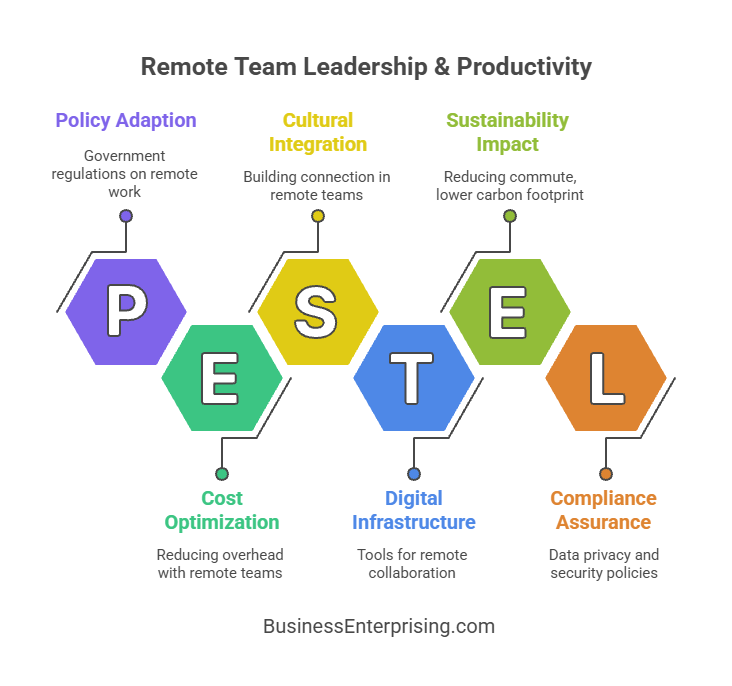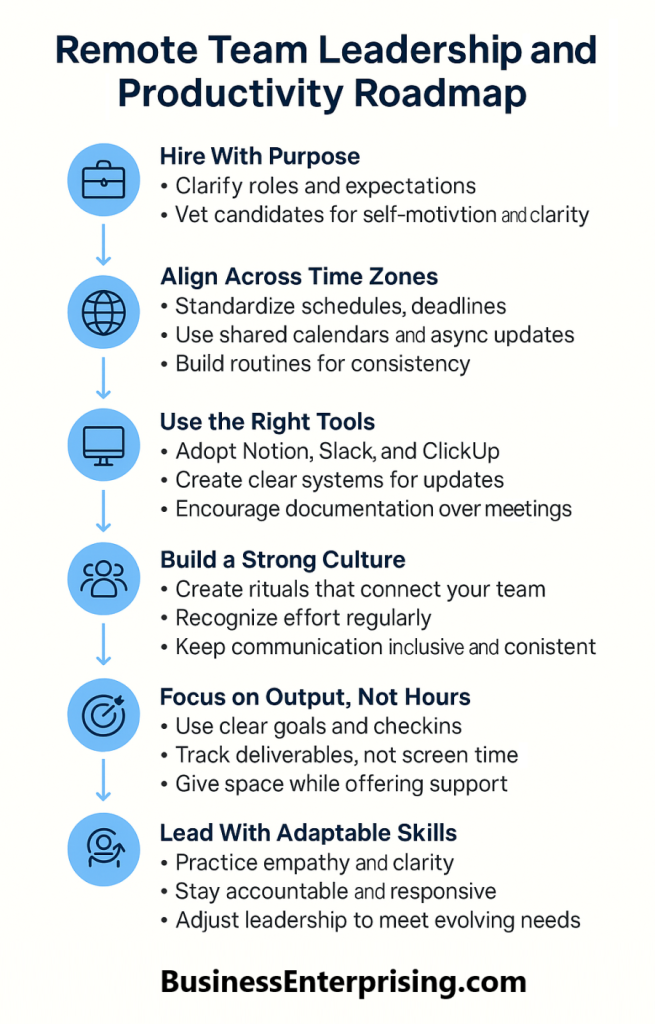
Additionally, you face new challenges when everyone works in different locations. You can no longer rely on hallway chats or unplanned check-ins. Instead, you must set clear goals and build simple systems that support progress. That includes how you assign work, share updates, and follow through on tasks.
You also need to think differently about accountability and trust. People work better when they feel supported and respected. Therefore, your leadership style needs to balance structure with autonomy. Additionally, you should look at results, not activity.
Tools help, but your leadership habits matter more. You must communicate clearly, give feedback often, and adjust your style when needed. These actions help your team stay focused and connected over time. Additionally, they reduce friction and build long-term stability. Effective remote teams don’t happen by chance. They depend on thoughtful systems and strong leadership. When you focus on results and relationships, your team becomes more reliable and productive from any location.
Strategic Hiring and Onboarding of Virtual Assistants and Freelancers
Hiring virtual assistants and freelancers takes more than scanning resumes. You need people who are reliable, responsive, and self-motivated. Start by writing clear role descriptions that outline expectations, deadlines, and communication norms. That will help you attract candidates who can meet your needs and fit your style.
Interviewing remotely should focus on both skills and behavior. Use video to assess communication habits and responsiveness. Ask how they handle competing deadlines or sudden project changes. You want to understand how they think and work independently. Additionally, test their ability to follow instructions. Give a short task and evaluate both results and how they ask questions.
After hiring, onboarding sets the tone for everything. Provide simple documentation that explains tools, workflows, and communication channels. Keep instructions clear and easy to reference. Meet with them to answer questions and set expectations. Therefore, they begin with direction and focus instead of confusion.
Additionally, introduce them to your work habits and time zones. This helps build mutual respect and avoid misunderstandings. You should also explain when updates are expected and what format works best for you. Early alignment saves time later.
Remote team leadership and productivity depends on strong onboarding. People do better when they know what to do and how to reach you. Therefore, set the standard right away. Make feedback part of the process and check in weekly at first. That helps you catch small issues before they grow. With a strong start, your freelancers or assistants can work more independently while staying aligned with your goals.
Managing Distributed Teams Across Time Zones
Working with people across different time zones can create confusion if you don’t plan ahead. Start by setting clear expectations early. Define work hours, communication windows, and deadlines in one time zone to avoid confusion. Use tools that automatically convert times so no one guesses meeting schedules.
Additionally, staggered schedules can work to your advantage. When one person finishes a task, someone else in another region can pick it up. Therefore, you keep momentum going without needing everyone online at once. However, you must still agree on when real-time meetings will happen. Keep them short and focused to respect everyone’s schedule.
You should also keep a shared calendar. Block times for group meetings, solo work, and flexible hours. This helps everyone know when others are available. Additionally, document key updates so team members don’t miss decisions if they’re offline. Clear written communication keeps projects moving when people work at different times.
Managing expectations becomes easier with consistent routines. Use the same format for reports, check-ins, and updates. Therefore, your team knows what to prepare and when to submit it. That cuts down on back-and-forth and delays.
Remote team leadership and productivity depends on clarity, structure, and adaptability. You can’t expect everyone to work the same hours. However, you can align your team around shared processes and predictable rhythms. With thoughtful planning, you create a system that supports everyone’s productivity without constant disruption.
Tools for Asynchronous Collaboration and Project Management
Asynchronous tools give your remote team more flexibility. You don’t need to be online at the same time to stay productive. Platforms like Notion help you organize documents, instructions, and resources in one central place. Therefore, everyone can find what they need without asking for it.
Slack helps reduce email and keeps discussions organized. Use channels for projects, updates, and questions. This keeps messages grouped by topic and easy to follow. Additionally, team members can respond when they’re available instead of feeling pressured to reply immediately.
ClickUp is helpful for managing tasks and deadlines. You can assign work, add notes, and track progress visually. Therefore, everyone knows what to do next without daily check-ins. It also helps you identify delays early and keep things moving.
Additionally, using the same tools across your team creates consistency. People know where to post updates, ask questions, and find documents. That cuts down on missed messages and repeated work. However, you still need to guide your team on how to use each tool effectively.
Remote team leadership and productivity depends on making asynchronous work smooth and predictable. Clear expectations and the right platforms allow you to get more done without meetings. With these systems in place, your team works at their own pace while staying connected to the bigger picture.
Building and Sustaining Company Culture in a Remote Environment
Remote teams need more than tools to work well together. You also need to build a sense of connection and shared purpose. Without face-to-face contact, relationships fade unless you create opportunities for interaction. Therefore, culture must be part of your regular work habits.
Start with small rituals that repeat weekly or monthly. You might hold brief check-ins, informal chats, or shared planning sessions. These help people feel seen and heard. Additionally, you should rotate who leads these calls to keep them fresh and inclusive.
Recognition matters more than you think. Highlight good work in your chat channels or weekly recaps. Let people know their efforts matter. Therefore, they stay motivated and feel part of something larger than their screen. Additionally, encourage peer-to-peer praise so it doesn’t always come from the top.
Clear communication helps maintain trust. Use direct language and follow through on what you say. You should also explain decisions openly. That keeps people informed and reduces confusion. Additionally, create space for feedback without penalty.
Remote team leadership and productivity depend on more than deadlines. A strong culture makes work smoother and more enjoyable. You don’t need constant contact. However, you do need regular signals that people matter and that their work fits the bigger picture.
Measuring Remote Team Productivity Without Micromanaging
Micromanaging creates tension and slows down your team. People work better when you focus on results, not activity. Therefore, shift your attention to outcomes that show progress. Use clear metrics tied to actual deliverables, not time spent online.
Additionally, regular check-ins help keep projects on track. You don’t need daily calls. A quick weekly meeting gives space to review tasks and flag issues. This keeps communication open without interrupting deep work. Therefore, you stay informed without hovering.
You should also align goals at the start of every project. Let each person know what success looks like. That reduces confusion and keeps everyone focused. Additionally, break larger goals into smaller pieces. This makes it easier to track progress and spot delays early.
However, resist the urge to track hours. Time doesn’t equal quality. You need to see what’s getting done and how it supports your larger goals. Use shared dashboards or progress boards to keep things transparent. That allows everyone to stay aligned without constant updates.
Remote team leadership and productivity improve when you trust people to do their jobs. That trust grows when expectations are clear and feedback is regular. Your job is to set direction, remove barriers, and support performance without standing over anyone’s shoulder.
Leadership Skills That Drive Success in Remote Workforces
Remote leaders need a different skill set than those in traditional office roles. You don’t get body language or hallway chats. Therefore, digital communication must be clear, consistent, and timely. Use simple language and avoid vague instructions. Additionally, ask for feedback to confirm your message landed as intended.
Empathy also plays a big role. Without casual interaction, people may feel isolated or overlooked. You should check in often and listen more than you speak. Therefore, you’ll catch problems early and build trust over time. Additionally, small gestures like acknowledging personal wins can strengthen connection.
Accountability sets the tone for your entire team. If you follow through on commitments, others are more likely to do the same. Be honest about mistakes and quick to adjust when things go off track. Therefore, your team learns that accountability doesn’t mean blame. It means ownership.
Adaptability keeps your team stable when things change. Remote work moves fast. Priorities shift and tools evolve. You must lead through that without losing focus. Additionally, you should help others feel confident when plans change. Your flexibility gives them permission to adjust without stress. Remote team leadership and productivity depend on the right habits. You won’t always get everything right. However, if you lead with empathy, clarity, and consistency, you’ll earn trust and drive results.
Conclusion
Remote work gives your team more flexibility, but it also demands more structure. You set the tone with clear leadership habits. Therefore, your choices shape how well people work and connect across time zones and roles.
Additionally, your hiring process plays a major role. When you bring in the right people and support them from the start, things go more smoothly. Tools help, but communication practices carry even more weight. Therefore, spend time refining how your team shares updates, asks questions, and tracks progress.
You don’t need constant meetings to stay aligned. With the right systems, people can work independently while still supporting team goals. Additionally, rituals and feedback loops help keep culture strong and projects on track. These habits make a difference over time.
Remote team leadership and productivity come from trust, structure, and shared goals. Your role is to guide, support, and adjust as needed. Therefore, stay flexible and lead by example. You’ll see stronger results and fewer slowdowns. Lead with consistency. Communicate clearly. Focus on results over time. That’s how remote teams grow, thrive, and deliver.



